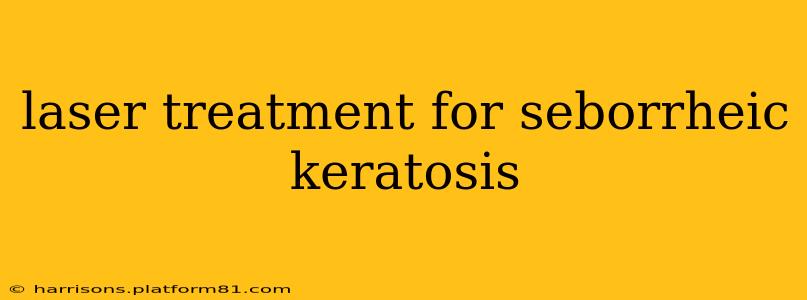Seborrheic keratosis (SK) are common, benign skin growths that often appear as waxy, raised bumps. While generally harmless, their appearance can be bothersome, leading many to seek removal. Laser treatment has emerged as a popular and effective method for managing SKs, offering several advantages over other removal techniques. This guide explores laser treatment for seborrheic keratosis, addressing common questions and concerns.
What is Laser Treatment for Seborrheic Keratosis?
Laser treatment utilizes focused beams of light to precisely target and destroy seborrheic keratosis lesions. Different types of lasers, such as carbon dioxide (CO2) lasers, erbium:YAG lasers, and pulsed dye lasers (PDL), can be employed depending on the size, number, and location of the SKs, as well as the patient's skin type. The laser energy selectively heats and ablates (removes) the SK tissue, leaving surrounding skin largely unaffected.
What are the Different Types of Lasers Used for Seborrheic Keratosis Removal?
Several laser types effectively treat seborrheic keratosis. The choice depends on factors like lesion characteristics and patient skin type. Let's examine some common options:
-
Carbon Dioxide (CO2) Laser: This is a widely used ablative laser, meaning it removes the top layer of skin. It's highly effective at removing SKs, but it can also cause some scarring or changes in skin pigmentation.
-
Erbium:YAG Laser: This ablative laser is often preferred over the CO2 laser because it causes less damage to surrounding tissue and typically results in less scarring.
-
Pulsed Dye Laser (PDL): This is a less ablative laser that targets blood vessels within the SK, causing it to shrink and eventually disappear. It's often used for smaller, flatter lesions.
Your dermatologist will determine the most appropriate laser for your specific situation.
How Does Laser Treatment for Seborrheic Keratosis Work?
The procedure is generally quick and minimally invasive. The dermatologist will clean the area and may apply a topical anesthetic to numb the skin. The laser is then precisely aimed at the SK, delivering controlled bursts of energy that vaporize the growth. The procedure usually takes just minutes per lesion. Larger or multiple lesions may require multiple treatment sessions.
Is Laser Treatment for Seborrheic Keratosis Painful?
While a topical anesthetic can minimize discomfort, some patients may experience mild stinging or burning during the procedure. The sensation is usually tolerable, and post-treatment discomfort is generally minimal.
What is the Recovery Time After Laser Treatment for Seborrheic Keratosis?
Recovery time varies depending on the type of laser used and the size of the lesions. Minor redness, swelling, and crusting are common and usually resolve within a few days to a couple of weeks. Your dermatologist will provide specific aftercare instructions to promote healing and minimize the risk of complications.
What are the Potential Side Effects of Laser Treatment for Seborrheic Keratosis?
While generally safe and effective, laser treatment can have potential side effects, including:
- Temporary redness and swelling: This is common and typically subsides within a few days.
- Crusting or scabbing: This is also common and will eventually fall off.
- Hypopigmentation or hyperpigmentation: Changes in skin color can occur, but they usually fade over time.
- Scarring: This is rare, but it's more likely with ablative lasers and larger lesions.
- Infection: This is a rare complication but is possible with any skin procedure.
How Much Does Laser Treatment for Seborrheic Keratosis Cost?
The cost of laser treatment for seborrheic keratosis varies depending on several factors, including the number of lesions, the size of the lesions, the type of laser used, and the geographic location. It's best to contact your dermatologist or a medical spa to obtain a personalized cost estimate.
Is Laser Treatment for Seborrheic Keratosis Covered by Insurance?
Insurance coverage for laser treatment of seborrheic keratosis varies widely depending on the insurance provider and the individual's policy. Many insurance companies do not cover cosmetic procedures, and whether or not SK removal is considered cosmetic will depend on the specific circumstances. It’s essential to check with your insurance provider directly to determine your coverage.
What are the Alternatives to Laser Treatment for Seborrheic Keratosis?
Besides laser treatment, other methods exist for SK removal, including cryotherapy (freezing), curettage (scraping), and surgical excision. The best approach depends on the individual's specific situation and preference, in consultation with a dermatologist.
This information is for general knowledge and should not be considered medical advice. Always consult a dermatologist or qualified medical professional for diagnosis and treatment of seborrheic keratosis or any skin condition. They can assess your individual needs and recommend the most appropriate treatment plan.
